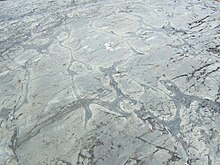Precambrian
| Precambrian | ||||||||||
|---|---|---|---|---|---|---|---|---|---|---|
| Chronology | ||||||||||
The Precambrian ( , where rocks from this age were first studied. The Precambrian accounts for 88% of the Earth's geologic time. The Precambrian is an informal unit of geologic time, OverviewRelatively little is known about the Precambrian, despite it making up roughly seven-eighths of the stromatolites) are of limited biostratigraphic use.[4] This is because many Precambrian rocks have been heavily metamorphosed, obscuring their origins, while others have been destroyed by erosion, or remain deeply buried beneath Phanerozoic strata.[4][5][6]
It is thought that Theia shortly after it formed, splitting off material that formed the Moon (see Giant-impact hypothesis). A stable crust was apparently in place by 4,433 Ma, since zircon crystals from Western Australia have been dated at 4,404 ± 8 Ma.[7][8]
The term "Precambrian" is used by paleontologists for general discussions not requiring a more specific eon name. However, both the United States Geological Survey[9] and the International Commission on Stratigraphy regard the term as informal.[10] Because the span of time falling under the Precambrian consists of three eons (the Hadean, the Archean, and the Proterozoic), it is sometimes described as a supereon,[11][12] but this is also an informal term, not defined by the ICS in its chronostratigraphic guide.[13]
Eozoic (from eo- "earliest") was a synonym for pre-Cambrian,[14][15] or more specifically Archean.[16] Life formsA specific date for the origin of life has not been determined. Carbon found in 3.8 billion-year-old rocks (Archean Eon) from islands off western Greenland may be of organic origin. Well-preserved microscopic fossils of bacteria older than 3.46 billion years have been found in Western Australia.[17] Probable fossils 100 million years older have been found in the same area. However, there is evidence that life could have evolved over 4.280 billion years ago.[18][19][20][21] There is a fairly solid record of bacterial life throughout the remainder (Proterozoic Eon) of the Precambrian. Complex multicellular organisms may have appeared as early as 2100 Ma.[22] However, the interpretation of ancient fossils is problematic, and "... some definitions of multicellularity encompass everything from simple bacterial colonies to badgers."[23] Other possible early complex multicellular organisms include a possible 2450 Ma red alga from the Kola Peninsula,[24] 1650 Ma carbonaceous biosignatures in north China,[25] the 1600 Ma Rafatazmia,[26] and a possible 1047 Ma Bangiomorpha red alga from the Canadian Arctic.[27] The earliest fossils widely accepted as complex multicellular organisms date from the Ediacaran Period.[28][29] A very diverse collection of soft-bodied forms is found in a variety of locations worldwide and date to between 635 and 542 Ma. These are referred to as Ediacaran or Vendian biota. Hard-shelled creatures appeared toward the end of that time span, marking the beginning of the Phanerozoic Eon. By the middle of the following Cambrian Period, a very diverse fauna is recorded in the Burgess Shale, including some which may represent stem groups of modern taxa. The increase in diversity of lifeforms during the early Cambrian is called the Cambrian explosion of life.[30][31] While land seems to have been devoid of plants and animals, cyanobacteria and other microbes formed prokaryotic mats that covered terrestrial areas.[32] Tracks from an animal with leg-like appendages have been found in what was mud 551 million years ago.[33][34] Emergence of lifeThe RNA World hypothesis assumes that RNA evolved before coded proteins and DNA genomes. Planetary environment and the oxygen catastrophe Evidence of the details of Sturtian-Varangian glaciation, around 850–635 Ma, which may have brought glacial conditions all the way to the equator, resulting in a "Snowball Earth".[citation needed ]
The atmosphere of the early Earth is not well understood. Most geologists believe it was composed primarily of nitrogen, carbon dioxide, and other relatively inert gases, and was lacking in free oxygen. There is, however, evidence that an oxygen-rich atmosphere existed since the early Archean.[38]
At present, it is still believed that oxygen catastrophe. At first, oxygen would have quickly combined with other elements in Earth's crust, primarily iron, removing it from the atmosphere. After the supply of oxidizable surfaces ran out, oxygen would have begun to accumulate in the atmosphere, and the modern high-oxygen atmosphere would have developed. Evidence for this lies in older rocks that contain massive banded iron formations that were laid down as iron oxides.
Subdivisions
A terminology has evolved covering the early years of the Earth's existence, as Timetable of the Precambrian .
It has been proposed that the Precambrian should be divided into eons and eras that reflect stages of planetary evolution, rather than the current scheme based upon numerical ages. Such a system could rely on events in the stratigraphic record and be demarcated by GSSPs. The Precambrian could be divided into five "natural" eons, characterized as follows:[42]
Precambrian supercontinentsThe movement of Earth's Yilgarn craton and Kalahari. The supercontinent Columbia, or Nuna, formed 2.1–1.8 billion years ago and broke up about 1.3–1.2 billion years ago.[43][44] The supercontinent Rodinia is thought to have formed about 1300-900 Ma, to have embodied most or all of Earth's continents and to have broken up into eight continents around 750–600 million years ago.[45]
See also
References
Further reading
External linksWikimedia Commons has media related to Precambrian.
| ||||||||||




